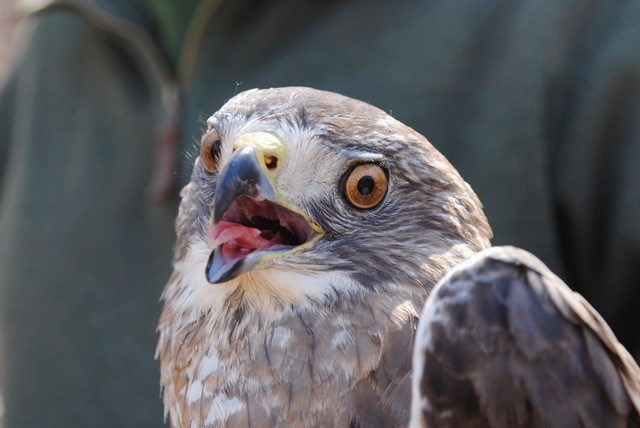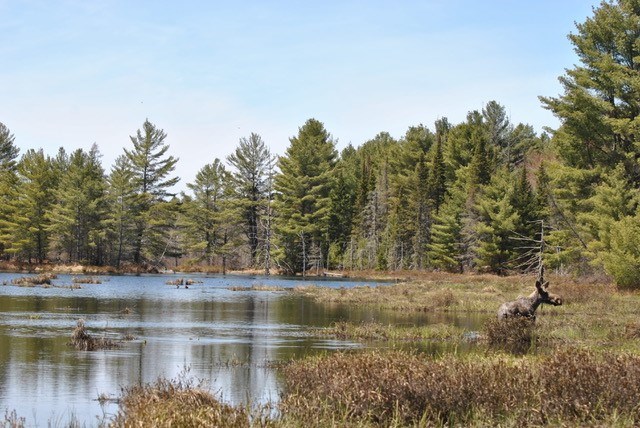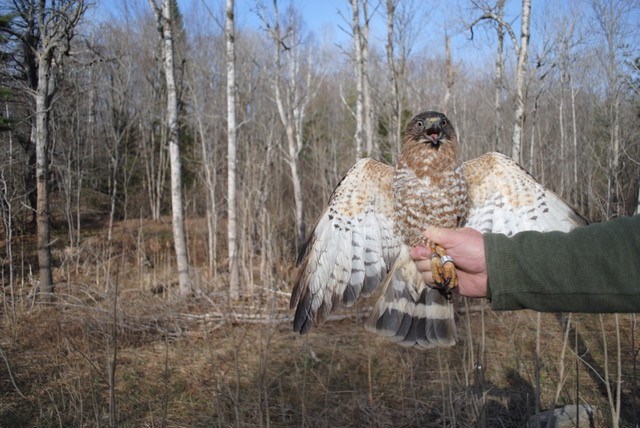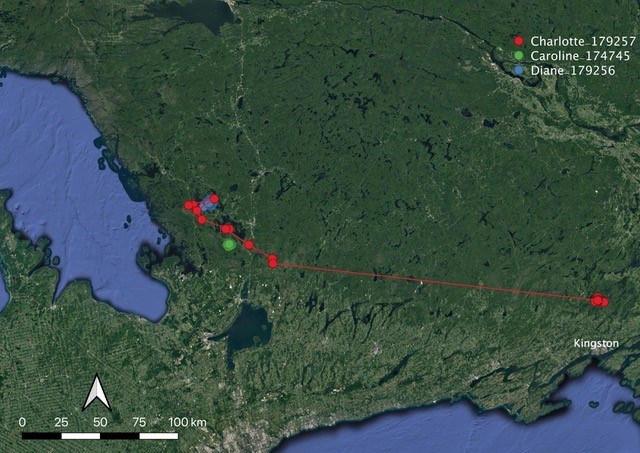A Canadian Collaboration: Part 2
Posted on in In the Field by R. McCabe, C. England, M. Wilson

Day 1: I arrived in the Muskoka’s on a Monday afternoon to meet Charlotte and Malcolm for a few fun-filled days trapping broad-winged hawks (hereafter broadwing). I was excited to see first-hand what road-trapping broadwings in Canada was all about. I had three 9.5 g solar-powered transmitters with me and two and a half days to deploy them. After my arrival we set out to find some broadwings along roads where Charlotte and Malcolm had seen them before. No more than 20 minutes in, Charlotte spots one perched low on a branch next to the road. She drops a bal-chatri trap in view of the perched broadwing, and I kid you not, it takes 10 seconds before the broadwing drops down on the trap and gets caught. Now this is what I am talking about! Charlotte safely retrieves the bird from the trap and begins to process it. This individual was a male and it was too small to get a transmitter (note: transmitters and harness weigh less than 3% of the birds body mass), so after being banded we released it and continued on.
We trapped a few more males, but finally in the evening on our last drop we got a female. Weighing over 500 g, she was eligible for a transmitter. As we released her with her new lightweight backpack, a Barred Owl flew in to a nearby tree as it was being chased by a second broadwing. Charlotte quickly dropped the trap in hope of the owl being a re-trap (they banded a Barred Owl in this area last year). It swooped in immediately and was caught. Charlotte and Malcolm processed the Barred Owl and off it went. What a thrill it was to have both birds back-to-back! We finished the day with 25 broadwing sightings and eight birds banded.

Day 2: Our second day began with a 5:30 am wake up, a hot cup of coffee and a quick breakfast for the road. Just after dawn (and the current temperature -1 degrees) we set out on the most productive part of the survey route and soon spotted our first broadwing. After 10 minutes with no interest, we scoped the bird and could see it had a metal band on one leg only, a bird from 2018! Sadly we could not know for sure who it was without a color band. We worked the usual circuit which mainly follows mature woodland with a mix of deciduous and conifer. We got our first new bird of the day sometime after, then spotted another which we had seen in the exact same spot the previous week. It was not interested in our trap, so on scoping it we were able to read X31, a bird we had banded in exactly the same place the previous year. Soon after this we caught another broadwing, a healthy adult female who qualified for a transmitter. We continued the survey route having traveled over 360 km, and although we did not catch any other females that day we did see a total of 27 broadwings and had a spectacular sighting of a moose!

Day 3: Wednesday morning started out the same as the previous day but instead of the normal survey route we decided to drive further north into a more remote forest. With only a few hours to deploy the last transmitter the anticipation was high. Fortunately, it settled by 8:30 am when we trapped our third adult female weighing over 400 g. Malcolm and I decided to name this bird after the woman with a keen eye for spotting Broadwings, Charlotte.
From the transmitter data thus far, we were surprised to see that Charlotte moved 270 km east and settled just north of Kingston, Ontario. As of June, we suspect all three females to have nested due to the localized telemetry data. As they tend to their young this summer, we will anxiously await the start of fall migration so we can follow them on their southbound journey.
Check out Part I of A Canadian Collaboration here.
Note: This research was conducted in a Covid-free region in Ontario. Researchers took precautions, self-isolated prior to trapping, and upheld safety measures to protect themselves and those around them.
